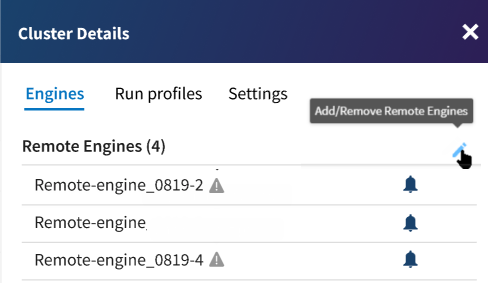Assigning Remote Engines to clusters
It is recommended to only add Remote Engines with the same version to a cluster.
In addition, if you have specified an engine to use a specific Java version to run tasks and plans, ensure to configure the same version for all the engines in the same cluster; otherwise, unexpected issues may occur at runtime.
For further information about how to specify a Java version for task and plan executions, see Specifying a Java version to run Jobs or Microservices.
About this task
Procedure
Results
The number of engines belonging to a cluster appears in brackets next to its name on the Engines tab of the Processing page.
When choosing to run a Job task on the cluster, it is executed in a round-robin manner on the engines belonging to the cluster. The task is executed on the first available Remote Engine, then the next and so on, while putting the ones the task was executed on to the end of the list. If a Remote Engine is not available, the task is executed on the next available engine.
| Parallel | The tasks are deployed simultaneously to all the Remote Engines of the cluster. Before deploying a new version of a task, you will need to undeploy the currently running version, which will result in service interruption. |
| Rolling | If the Remote Engine cluster contains more than one Remote Engine, the tasks are deployed one by one to the Remote Engines of the cluster. This means that for a short time, different Remote Engines will be running different versions of the task, therefore you can avoid service interruption. |
Did this page help you?
If you find any issues with this page or its content – a typo, a missing step, or a technical error – let us know how we can improve!

 icon on the
icon on the 